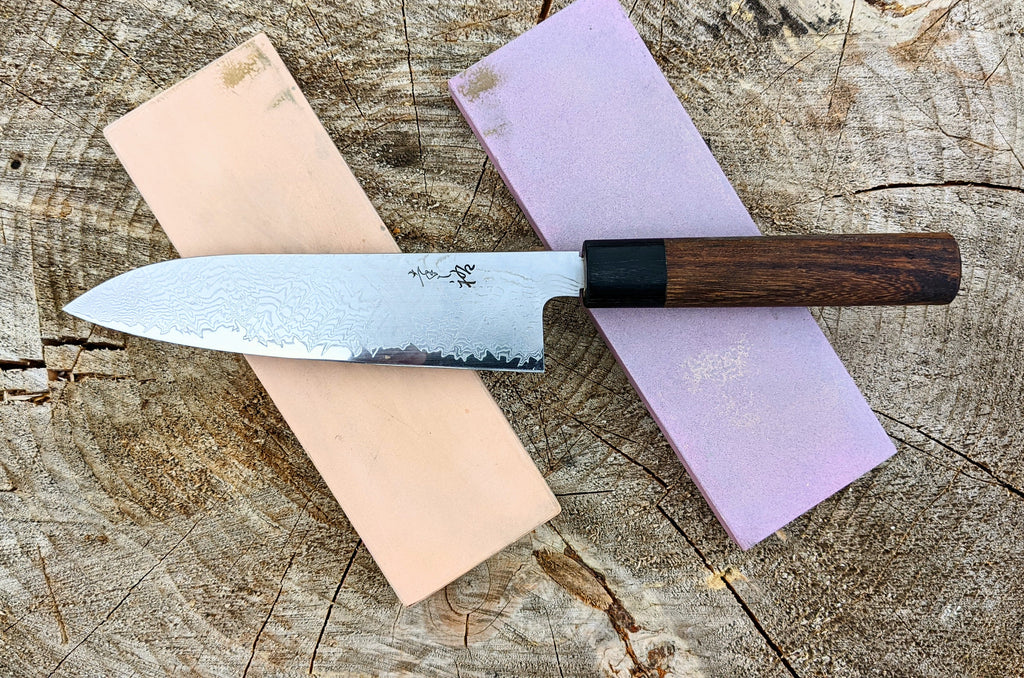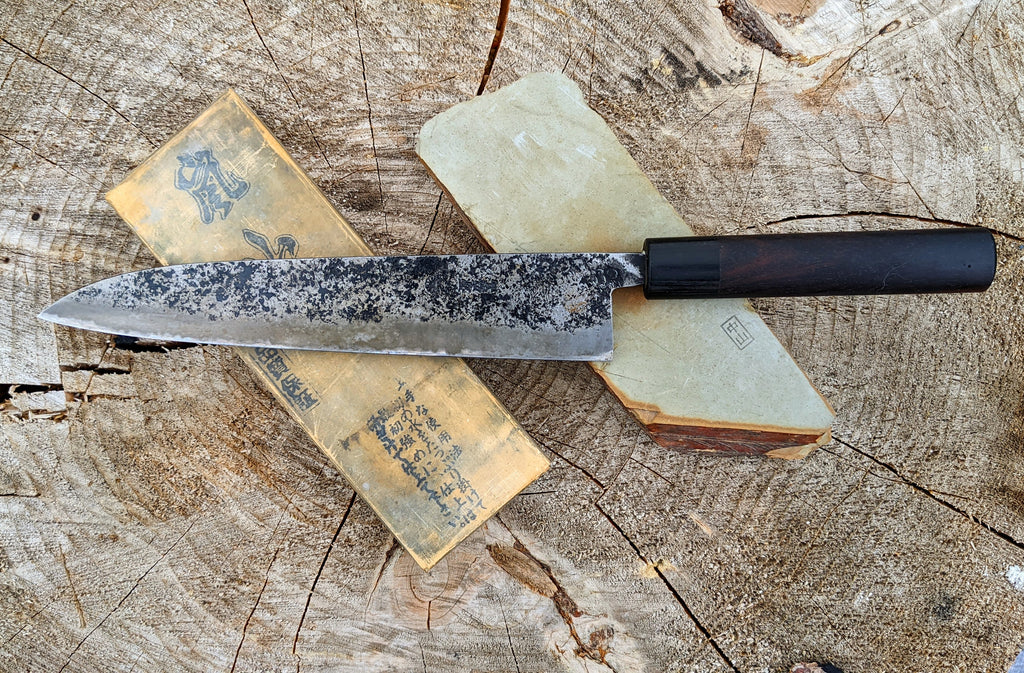How to Sharpen Carbon Steel Knives v.s. Stainless Steel Knives
Metallurgy is challenging and complex, and boring, and I don’t understand it. Furthermore, much like what an NFT is, I do not want anyone out there to try explaining it to me. I’m good. Ferrulites, carbides, manganese… I don’t really know what these words mean. Whenever I begin reading about metallurgy, I can feel my eyes start to glaze over like so many clay pots in so many kilns. My mind checks out of my brain, leaks out my ear, and begins focusing on other things. Interesting things. Stimulating things. Like fried chicken or “Elden Ring”. I am a simple man of simple taste, and I’m unwilling to change.
 thingsowenlikesmorethanmetallurgy.jpg
thingsowenlikesmorethanmetallurgy.jpg
So why would I write about something I do not understand? That’s the thing - I’m not going to! What I do understand are concepts related to kitchen knives. I know the steel they’re made from and how it relates to how they perform, and I know how to look after them. I understand what properties make a knife function well. I know how to use them effectively. I know how to sharpen them. I stand on the shoulders of gigantic steel nerds; without their sacrifice of learning all the boring stuff, I would be but an uneducated peon toiling in the mires of ignorance. Thanks, nerds!
If you’re looking for in-depth charts and atomic weights of molecules, go ahead and click that “back” button. That’s not my game. If you’re looking for some handy and easy-to-understand advice on sharpening, read on!
So without further ado, let's talk steel! I promise not to get too technical. There are two basic groupings of knife steel: stainless steel and high-carbon steel - which I will refer to henceforth as simply “stainless” and “carbon” for brevity’s sake
Stainless is stainless because of chromium. Chromium is a metallic element. Chromium does not rust, which is nice. Yay! However, chromium is also soft and wear-resistant, which is less nice. Soft materials don’t hold an edge as well, but wear-resistant materials also do not respond quickly to sharpening stones. Boo!
Carbon is not stainless. Carbon rusts. Boo! However, carbon does not contain chromium. That means that carbon is harder and less wear-resistant. This means it can hold an edge better than stainless and responds more quickly to sharpening stones. Yay!

Carbon steel and stainless steel have different chemical compositions, which can have a big effect of how they sharpen.
(Note: Yes, yes, yes, pipe down, nerds. I’m generalizing. I know there are exceptions to these rules. Stuff like R2 and ZDP-189 and SG2 and SRS steels are really, really, really hard and are totally stainless. Let’s just keep it simple for now; we all have places to be and stuff to do after this. Moving on…)
Easy right? I think this is a pretty basic concept that's easy to comprehend. Carbon steel is fussy, but it’s worth the extra care because of its brilliant edge retention and sharpenability. However, you’re more than welcome to disagree - stainless is very convenient, especially if you’re working in a busy kitchen and don’t have the time to care for your knife correctly. Don’t let me tell you what you want. You do you!
So to the point - how does one sharpen these types of steel? Again, let’s keep it nice and straightforward. I sharpen dozens of knives every day at my shop, and I’ve learned a whole ton about what works best for what kind of knives. Let’s start with Japanese stainless steel:
 Stainless steel knives usually sharpen well on any quality synthetic whetstone.
Stainless steel knives usually sharpen well on any quality synthetic whetstone.
How to Sharpen Japanese Stainless Steel
I get the best results when sharpening Japanese stainless knives with my Naniwa Professional stones or Shapton stones. These synthetic stones are highly consistent, hard, and easy to use. None of them require soaking. They hold their shape quite well and have pleasant feedback. They give my stainless knives a nice crispy edge that looks beautiful and shiny and holds up very well with a little bit of love. Think of it this way - stainless steel is pretty high-tech, so I will use my high-tech stones to sharpen it. The specific grit of stones you’ll want to choose depends on both the type of steel and what the knife is being used for. High-end stainless like VG-10? I would say the Naniwa Pro 3000 or the Shapton 4000. Powder steel like R2? Naniwa Pro 5000 or 10,000, or the Shapton 6000 or 10,000. As a general rule, if my knife is used for meats and fish, I’ll go with a very high grit polish, like a 10,000 grit. If the blade is more for chopping up veggies and such, 3000-6000 grit is fine.

Carbon steel knives seem to fare best with natural sharpening stones, and Imanishi synthetic stones.
How to Sharpen Japanese Carbon Steel
Carbon steels will also polish and sharpen perfectly fine using these same stones, but if you really want to take advantage of the unique toothiness that carbon steel can provide, I would strongly recommend using Japanese natural finishing stones. Something like the Oohira Model 40 is ideal - similar to the Naniwa Pro and Shapton, it is very hard, but because it is literally a chunk of stone mined from a mountain, there is no discernable grit number that can be attached to it. Natural stones and carbon steel are an iconic duo - like mac and cheese or Keith Richards and Mick Jagger - and much like Keith and Mick, their unique talents and properties have been appreciated and revered by many, many generations of fans. The unique feel you get from cutting with a carbon knife that has been lovingly sharpened on a Japanese natural stone is almost indescribable. It doesn’t feel like gliding through the air - there is a definite, tangible sensation of the knife slicing through the food - It almost feels like the blade has a will of its own, and it wants nothing more than to bite into the cutting board beneath. It’s something that you need to experience for yourself! In short, natural stones are the best way to go here, but you can also get a similar result from the Imanishi 6000 grit “Arashiyama” or the 8000 grit “Kitayama” for a bit less money! Also, it's essential to take your time with the finishing stones, specifically with carbon steels. As you continue to sharpen, you’ll notice that a little bit of “mud” develops on the stone's surface. This is a mixture of stone and steel that blends into a delicious sharpening goulash. It’s going to help achieve a consistent overall finish much faster. Keep your stone nice and lubed with fresh water, but do your best not to wash all this mud away - it’s valuable stuff!
So what else do you need? In terms of low grit stones, there isn’t really a wrong choice at our shop. The Knifewear 220 does an excellent job for any steel type, but if you want to get fancy, grab yourself the Shapton 220. It doesn’t need any soaking and works really fast. You should also get a 1,000 grit stone to establish a good clean edge before you start polishing. I recommend the Naniwa Professional 1000. It’s the best, and you deserve it. After polishing, you should also strop your knife; it makes a huge difference. Also, don’t forget to get a truing stone - if your fancy stones get dished out, they’re not going to work as intended, and you’ll just be wasting your time and money. For info on how to use all these goodies, just check out Naoto's sharpening video!
Hey, wow, we managed to get through a whole article about sharpening without once using the phrase “J-Nat”! I would count that as an absolute win for the proletariat knife nerd community. If you really want to geek the eff out, though, more power to ya. Check out our YouTube channel, where you can see all of these tools in action. We’re more of a “don’t tell, show” kinda crowd, to be honest. Also, it’s probably not a bad idea to sign up for a sharpening class at one of our shops; it comes with some pretty killer discounts on the tools you need. Thanks for reading, and stay sharp!





